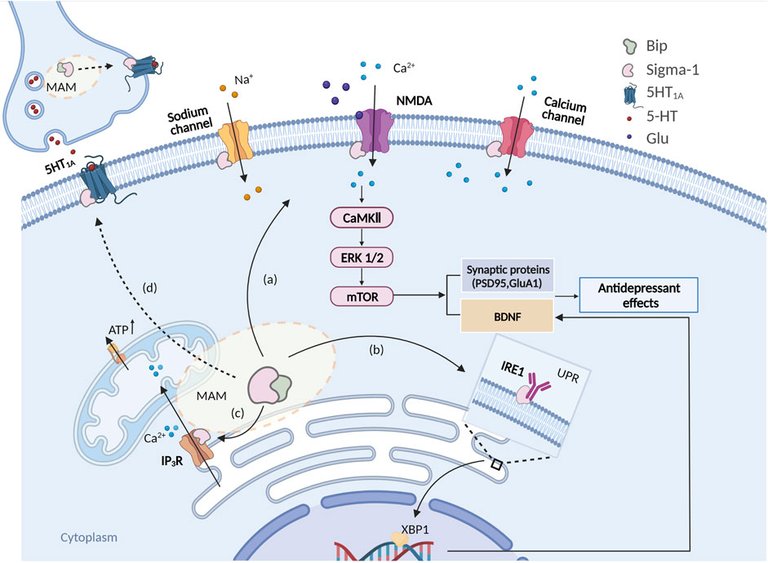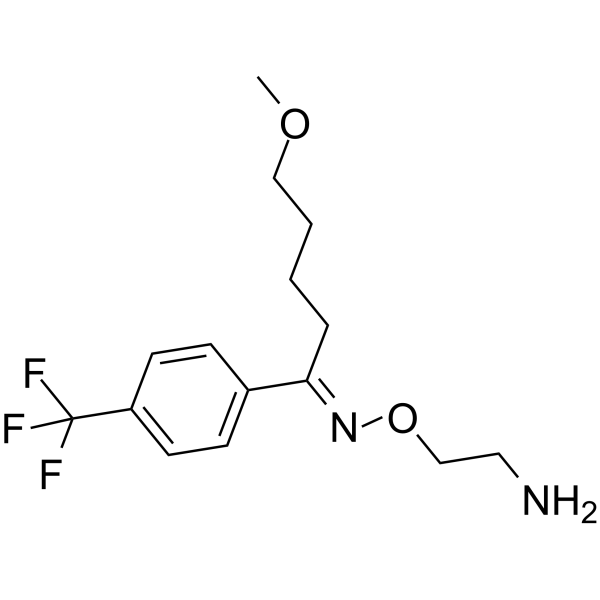In the midst of the constant shipwreck that is the self-search for psychological sanity, I've been going over and over a lot of technical and sometimes even somewhat obscure information about some alternatives and experimental strategies. The search itself (which is the ignitor of this action) already denotes that I haven't reached a safe harbor (will I ever?), but the fact is that I've found some relevant information that I haven't yet shared about a little-talked-about receiver, the Sigma1.
Source

The Sigma-1 receptor (σ₁) is a multifunctional protein that has recently attracted significant attention in neuroscience due to its functions in cellular homeostasis and in various pathologies, such as neurodegenerative, psychiatric and inflammatory diseases. Since Sigma1 is an atypical transmembrane protein composed of approximately 223 amino acids (more specifically located predominantly in the endoplasmic reticulum), it is found in some specialized regions known by the acronym MAMs (Mitochondrial-associated membranes), basically a bridge region between the mitochondria and the endoplasmic reticulum. The fact is that Sigma1 is not a conventional receptor, as it works by organizing the dynamics between proteins and lipids, and with this format it has special potential for modulating intracellular calcium (by interacting with the Inosital triphosphate receptor), as well as stabilizing mitochondrial membranes and regulating oxidative and protein stress.
Even rudely, science is studying its relevance to neurodegenerative diseases such as Alzheimer's and Parkinson's, and in a perhaps neglected way, Sigma1 is interconnected with some psychiatric treatments because, consequently, it works in the regulation of some neurotransmitters on its own (such as dopamine, serotonin and glutamate), which is exactly where I will go into more detail later, and also in the modulation of inflammatory responses, helping for example in the inflammatory cytokine storms common in Covid.
Source

Of all the substances with an affinity for Sigma1 (Fluvoxamine, Donepezil, Igmesin, PRE-084, among others) the one with the most potency and efficiency in this regard is Fluvoxamine. Which gave me an investigative itch. I used fluvoxamine for about 8 months in the past and stopped taking it out of stupidity, because it worked well and had few side effects. Let me tell you a little about Fluvoxamine. It was developed in the 1970s but only introduced to the market in 1983 as the first selective serotonin reuptake inhibitor (SSRI) approved for the treatment of obsessive-compulsive disorder (OCD) and depression. Although Fluvoxamine came first, it was Fluoxetine, the famous Prozac (a drug I hate, by the way) that gained the reputation as the "first antidepressant" thanks to extremely robust marketing. In the end, Fluvoxamine's main intention is to selectively inhibit the serotonin transporter (SERT), thus increasing the concentration of serotonin in the synapse, but BY CHANCE, it has this super-potent affinity with the Sigma1 receptor (those occasional accidents of psychiatry - which in the end turn out to be more assertive than the plan itself).
Some useful technical information for pharmacology geeks: metabolized primarily by cytochrome P450 2D6 (CYP2D6), with inactive metabolites. Its half-life varies between 15 and 22 hours, allowing it to be administered once or twice a day. It is excreted mainly by the kidneys. Regarding the receptor targeted in this text, fluvoxamine is a potent agonist of the Sigma-1 receptor, with an affinity in the nanomolar range (Ki ~36 nM) and is independent of its relationship with serotonin. Activation of σ₁ by fluvoxamine reduces neuronal apoptosis, stabilizing mitochondria and reducing oxidative stress. By activating σ₁, fluvoxamine increases the release of dopamine and glutamate in critical brain regions such as the striatum and prefrontal cortex.
Some studies (and anecdotal reports in general) show that fluvoxamine's ability to act on σ₁ seems to mediate its anxiolytic and antidepressant effects, especially in patients refractory to other SSRIs. As a good guinea pig, I'm thinking of testing this strategy again, now in a new phase, given that I'm already being treated with Bupropion (and as you well know, given my history, nothing is permanent, everything changes and fails over time, it's my karma). Well, although relatively shallow, I hope this content has been enjoyable for you. Thanks for reading!

Português
Em meio ao naufrágio constante que é a auto busca pela sanidade psicológica eu tenho passado e repassado um calhamaço de informações técnicas e as vezes até um pouco obscuras sobre algumas alternativas e estratégias experimentais. A própria busca em si (que é o ignitor dessa ação) já denota que não cheguei a um porto seguro (será que um dia chegarei?), fato é que achei algumas informações relevantes que ainda não compartilhei à respeito de um receptor pouco comentado, o Sigma1.
Source

O receptor Sigma-1 (σ₁) é uma proteína multifuncional que tem tardiamente atraído atenção significativa na neurociência devido a suas funções na homeostase celular e em diversas patologias, como por exemplo doenças neurodegenerativas, psiquiátricas e inflamatórias. Sendo o Sigma1 uma proteína transmembranar atípica composta por aproximadamente 223 aminoácidos (mais especificamente localizada de forma predominante no retículo endoplasmático) ele está em algumas regiões especializadas conhecidas pela sigla MAMs (Mitochondrial-associated membranes), basicamente uma região ponte entre as mitocôndrias e o retículo endoplasmático. Fato é que o Sigma1 não é um receptor convencional, pois trabalha organizando a dinâmica entre proteínas e lipídios, e com essa formatação ele tem um potencial especial na modulação do cálcio intracelular (interagindo com o receptor de Inosital trifosfato), além de estabilizar as membranas mitocondriais, regular o estress oxidativo e proteico.
Ainda rudemente, a ciência estuda sua relevância para doenças neurodegenerativas como Alzheimer e Parkinson, e de forma talvez negligenciada o Sigma1 está interconectado com alguns tratamentos psiquiátricos pois, por consequência trabalha na regulação de alguns neurotransmissores por si só (como dopamina, serotonina e glutamato), que é exatamente onde irei aprofundar logo mais, e também na modulação de respostas inflamatórias, auxilizando por exemplo nas tempestades de citocinas inflamatórias comuns no Covid.
Source

Dentre todas as substâncias com afinidade ao Sigma1 (Fluvoxamina, Donepezila, Igmesina, PRE-084, entre outras) a que mais tem potência e eficiência nesse sentido é a Fluvoxamina. O que me causou um comichão investigativo. Já utilizei por um período de uns 8 meses a fluvoxamina no passado e parei com ela por estupidez mesmo, porque funcionava bem e tinha poucos colaterais. Mas vamos ao que interessa, deixe-me contar um pouco sobre a Fluvoxamina. Ela foi desenvolvida na década de 1970 porém introduzida no mercado apenas em 1983 como o primeiro inibidor seletivo da recaptação de serotonina (ISRS) aprovado para o tratamento do transtorno obsessivo-compulsivo (TOC) e depressão. Apesar da Fluvoxamina ter vindo antes, quem ganhou a fama de "primeiro antidepressivo" graças a um marketing extremamente robusto foi a Fluoxetina, o famoso Prozac (um medicamento que eu odeio, aliás). No final das contas, a intenção principal da Fluvoxamina é a inibição seletiva do transportador de serotonina (o SERT), aumentando então a concentração de serotonina na sinapse, mas POR ACASO, ele tem essa afinidade super potente com o receptor Sigma1 (esses acidentes ocasionais da psiquiatria - que no final das contas acabam sendo mais assertivos que o próprio plano em si).
Algumas informações técnicas úteis para os geeks da farmacologia: metabolizada primariamente pelo citocromo P450 2D6 (CYP2D6), com metábolitos inativos. Sua meia vida varia entre 15 e 22 horas, permitindo administração única ou duas vezes ao dia. É excretada principalmente pelos rins. Sobre o receptor alvo desse texto, a fluvoxamina é um potente agonista do receptor Sigma-1, com afinidade na ordem de nanomolares (Ki ~36 nM) e independe da relação com a serotonina. A ativação do σ₁ pela fluvoxamina reduz a apoptose neuronal, estabilizando mitocôndrias e diminuindo o estresse oxidativo. Ao ativar o σ₁, a fluvoxamina aumenta a liberação de dopamina e glutamato em regiões cerebrais críticas, como o estriado e o córtex pré-frontal.
Alguns estudos (e os relatos anedóticos em geral) evidenciam que a capacidade da fluvoxamina de atuar no σ₁ parece mediar seus efeitos ansiolíticos e antidepressivos, especialmente em pacientes refratários a outros ISRS. Eu como boa cobaia, estou pensando em testar essa estratégia novamente, agora numa nova fase, dado que já faço tratamento com a Bupropiona (e que como bem sabem, diante de meu histórico, nada é permanente, tudo muda e falha ao passar do tempo, é o meu karma). Bom, ainda que relativamente raso, espero que esse conteúdo tenha sido agradável para vocês. Obrigado pela leitura!
Thanks for your contribution to the STEMsocial community. Feel free to join us on discord to get to know the rest of us!
Please consider delegating to the @stemsocial account (85% of the curation rewards are returned).
You may also include @stemsocial as a beneficiary of the rewards of this post to get a stronger support.